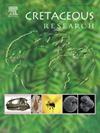日本上侏罗统—下白垩统Tetori群区域对比的碳同位素地层学
IF 1.9
3区 地球科学
Q1 GEOLOGY
引用次数: 0
摘要
非海相地层的区域对比对理解陆地环境变化具有重要意义,但仍具有挑战性。应用碳同位素地层学对日本中西部地区上侏罗统—下白垩统Tetori群进行了初步的区域对比。为了加强这一对比的可信度,新的U-Pb锆石定年结果显示,来自伊月组的凝灰岩的加权平均年代为128.8±1.4 Ma (Hauterivian)。三个不同的样品是在鸟居群的几个地层中收集的。测定其有机碳同位素比值(δ13Corg),评价其水平变化。Tamodani和Itoshirogawa伐木路段有机碳的地层波动范围在- 25.5 ~ - 19.5‰之间。得到的δ13Corg曲线有一个显著的特征,即在两剖面的上部均有较大的δ13Corg值,超过−22 ~−20‰,而在两剖面的中部则有较大的δ13Corg值,约为−25‰。在阿普提亚,与OAE1a相关的Hauterivian长期负偏移和正偏移可能与这些剖面相关。将这些同位素曲线与亚洲其他地区的同位素曲线进行比较,发现与OAE1a有关的- 20 ~ - 22‰正偏移可以与亚洲其他剖面直接相关。该研究可作为一个基准,展示了利用碳同位素地层学在Tetori群内进行区域对比的潜力。本文章由计算机程序翻译,如有差异,请以英文原文为准。

Carbon isotope stratigraphy for regional correlation of the Upper Jurassic–Lower Cretaceous Tetori Group in Japan
Regional correlation of non-marine strata is challenging despite its crucial importance in understanding terrestrial environmental transitions. This study applied carbon isotope stratigraphy for preliminary regional correlation of the Tetori Group, an Upper Jurassic to Lower Cretaceous shallow marine and non-marine siliciclastic succession in west-central Japan. To strengthen credibility for this correlation, new U–Pb zircon dating on a tuff from the Itsuki Formation provides a weighted average date of 128.8 ± 1.4 Ma (Hauterivian). Three separate samples were collected from several stratigraphic horizons within the Tetori Group. Their organic carbon isotope ratio (δ13Corg) was determined to assess the horizontal variation of the values. The stratigraphic fluctuation of organic carbon within the Tamodani and Itoshirogawa logging road sections ranged within ca. −25.5 to −19.5 ‰. A notable character in the obtained δ13Corg curves is the large values exceeding ca. −22 to −20 ‰ in the upper parts of both sections, coupled with underlying low values of ca. −25 ‰ in the middle parts of both sections. The Hauterivian long-term negative excursion and the positive excursion associated with OAE1a in the Aptian are plausible events potentially correlated to these sections. These isotopic curves were compared with those from other regions of Asia, and it is noted that the −20 to −22 ‰ positive excursion related to the OAE1a can be correlated directly with other Asian sections. This study serves as a benchmark, showcasing the potential for regional correlation within the Tetori Group using carbon isotope stratigraphy.
求助全文
通过发布文献求助,成功后即可免费获取论文全文。
去求助
来源期刊

Cretaceous Research
地学-地质学
CiteScore
4.10
自引率
19.00%
发文量
235
审稿时长
12 weeks
期刊介绍:
Cretaceous Research provides a forum for the rapid publication of research on all aspects of the Cretaceous Period, including its boundaries with the Jurassic and Palaeogene. Authoritative papers reporting detailed investigations of Cretaceous stratigraphy and palaeontology, studies of regional geology, and reviews of recently published books are complemented by short communications of significant new findings.
Papers submitted to Cretaceous Research should place the research in a broad context, with emphasis placed towards our better understanding of the Cretaceous, that are therefore of interest to the diverse, international readership of the journal. Full length papers that focus solely on a local theme or area will not be accepted for publication; authors of short communications are encouraged to discuss how their findings are of relevance to the Cretaceous on a broad scale.
Research Areas include:
• Regional geology
• Stratigraphy and palaeontology
• Palaeobiology
• Palaeobiogeography
• Palaeoceanography
• Palaeoclimatology
• Evolutionary Palaeoecology
• Geochronology
• Global events.
 求助内容:
求助内容: 应助结果提醒方式:
应助结果提醒方式:


